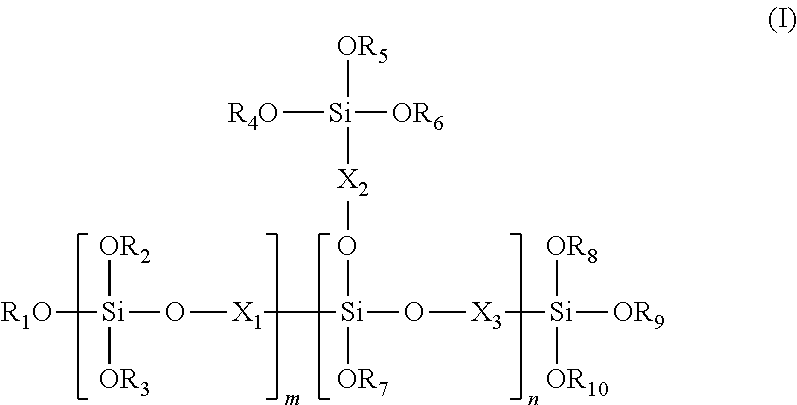Silicon oligomer and production method therefor
a technology of silicon oligomer and production method, which is applied in the direction of silicon organic compound, coating, etc., can solve the problems of difficult to achieve both corrosion resistance and function, and the coating liquid cannot keep the sol-gel properties, etc., to achieve excellent hydrolysis resistance, high reproducibility, and easy production.
- Summary
- Abstract
- Description
- Claims
- Application Information
AI Technical Summary
Benefits of technology
Problems solved by technology
Method used
Image
Examples
example 1
Preparation of a Silicon Oligomer:
[0064]To 336 g (5.4 mol) of ethylene glycol was added 1.8 g of aluminum chloride hexahydrate, and the resultant mixture was heated to 50° C. by means of a mantle heater while stirring, and 564 g (2.7 mol) of tetraethoxysilane (TEOS) was mixed into the mixture to effect a reaction for 2 hours without subjecting to fractional distillation of an alcohol formed during the substitution reaction. The temperature for the reaction was 50° C. or lower. Before the reaction, TEOS and ethylene glycol were not mixed with each other and suffered separation into two layers, but, after the reaction, they were changed to a single layer because TEOS was completely reacted. This means that the degree of reaction of TEOS is 100%.
[0065]After the reaction, cooling was performed to obtain a reaction product. Before and after the reaction, 1H NMR and 29Si NMR measurements were conducted. In the 1H NMR measurement, in the spectrum obtained after completion of the reaction, ...
example 2
Preparation of a Silicon Oligomer:
[0068]A silicon oligomer was prepared in substantially the same manner as in Example 1 except that the amount of ethylene glycol was changed to 83.9 g (1.35 mol).
[0069]Before the reaction, TEOS and ethylene glycol were not mixed with each other and suffered separation into two layers. Also after the reaction, the unreacted TEOS remained as the upper layer to cause separation into two layers. This means that the degree of reaction of TEOS is low.
[0070]However, from the fact that a film was able to be formed from the separated lower layer liquid by calcining it, it has been found that, although the yield was low, a silicon oligomer having the same structure as that in Example 1 was obtained.
example 3
Preparation of a Silicon Oligomer:
[0071]A silicon oligomer was prepared in substantially the same manner as in Example 1 except that the amount of ethylene glycol was changed to 177.8 g (2.7 mol).
[0072]Before the reaction, TEOS and ethylene glycol were not mixed with each other and suffered separation into two layers. Also after the reaction, the unreacted TEOS remained as the upper layer to cause separation into two layers. This means that the degree of reaction of TEOS is low.
[0073]However, from the fact that a film was able to be formed from the separated lower layer liquid by calcining it, it has been found that, although the yield was low, a silicon oligomer having the same structure as that in Example 1 was obtained.
PUM
| Property | Measurement | Unit |
|---|---|---|
| temperature | aaaaa | aaaaa |
| temperature | aaaaa | aaaaa |
| temperature | aaaaa | aaaaa |
Abstract
Description
Claims
Application Information
 Login to View More
Login to View More - R&D
- Intellectual Property
- Life Sciences
- Materials
- Tech Scout
- Unparalleled Data Quality
- Higher Quality Content
- 60% Fewer Hallucinations
Browse by: Latest US Patents, China's latest patents, Technical Efficacy Thesaurus, Application Domain, Technology Topic, Popular Technical Reports.
© 2025 PatSnap. All rights reserved.Legal|Privacy policy|Modern Slavery Act Transparency Statement|Sitemap|About US| Contact US: help@patsnap.com



